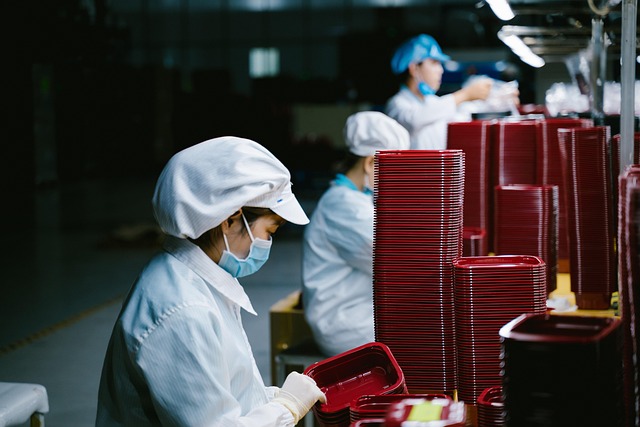5S training, rooted in Japanese manufacturing, offers a systematic approach to workplace organization and lean management. Comprising sorting, setting in order, cleaning (shining), standardizing, and sustaining, these principles enhance efficiency, reduce waste, improve quality, and drive continuous improvement. By implementing 5S continuous improvement, organizations transform workspaces, boost productivity, foster employee morale, and cultivate a culture of ongoing enhancement, ultimately achieving operational excellence. KPIs for 5S CI focus on waste reduction and employee engagement to measure success.
“Discover the power of continuous improvement with our comprehensive guide. Explore the core principles of 5S training, a proven method for enhancing productivity and efficiency. Learn how lean management techniques can revolutionize workflows, and unlock the benefits of well-organized workspaces. We delve into the significance of process standardization as a key driver for continuous improvement (CI). Understanding key performance indicators (KPIs) for 5S CI allows businesses to measure success and drive sustainable growth.”
- Understanding the Core Principles of 5S Training
- Implementing Lean Management for Efficient Workflows
- Unlocking Productivity through Workplace Organization
- The Role of Standardization in Continuous Improvement
- Measuring Success: Key Performance Indicators for 5S CI
Understanding the Core Principles of 5S Training

5S training is a cornerstone in lean management and workplace organization, offering a systematic approach to achieving efficiency through process standardization. This methodology, rooted in Japanese manufacturing practices, emphasizes sorting, setting in order, shining (cleaning), standardizing, and sustaining. Each principle builds upon the previous one, creating an environment conducive to continuous improvement.
By implementing 5S training, organizations can transform their workspace into a structured, organized, and clean area that promotes productivity and reduces waste. Sorting involves eliminating unnecessary items, setting in order ensures everything has its place, shining focuses on thorough cleaning, standardizing establishes consistent processes, and sustaining drives ongoing adherence to these principles. This framework not only enhances operational efficiency but also fosters a culture of continuous improvement within the organization.
Implementing Lean Management for Efficient Workflows

Implementing Lean Management for Efficient Workflows
In today’s competitive business landscape, adopting lean management principles is a game-changer for organizations seeking to optimize their processes and enhance productivity. Lean management, rooted in the renowned 5S training methodology, focuses on workplace organization and continuous improvement. By systematically sorting, setting in order, shining a light (seiketsu), standardizing processes, and continuously striving for perfection (shitsuke), businesses can achieve remarkable efficiency gains.
The 5S framework serves as a powerful tool for implementing lean management. It involves training employees to maintain a clean and organized workspace, establish clear standards for every task, ensure efficient material flows, and foster a culture of continuous improvement. This structured approach not only improves productivity but also reduces waste, enhances quality, and creates a safer working environment. Process standardization becomes inherent in the 5S methodology, enabling organizations to streamline operations and deliver superior value to their customers.
Unlocking Productivity through Workplace Organization

Unlocking Productivity through Workplace Organization
In today’s fast-paced business environment, maximizing productivity is paramount. One effective strategy to achieve this is by implementing robust workplace organization principles, with a specific focus on 5S training and lean management techniques. The 5S method—Sort, Set in Order, Shine (Clean), Standardize, and Sustain—serves as a powerful framework for process standardization, enabling employees to streamline workflows, reduce waste, and enhance overall efficiency. By teaching workers the art of minimizing clutter, establishing clear processes, and maintaining a clean, organized environment, organizations can unlock significant gains in productivity.
Moreover, integrating 5S continuous improvement into lean management practices fosters a culture of ongoing enhancement. Standardizing procedures ensures that tasks are executed consistently, while regular ‘shining’ sessions keep the workspace pristine. This systematic approach not only boosts employee morale by creating a more pleasant work environment but also facilitates easier error detection and problem-solving, ultimately driving operational excellence and sustained success.
The Role of Standardization in Continuous Improvement

Standardization plays a pivotal role in fostering a culture of continuous improvement within any organization. By implementing structured processes and consistent practices, businesses can create an environment conducive to identifying and eliminating waste. The 5S training method, a cornerstone of lean management, is instrumental in achieving this. This systematic approach involves sorting, setting in order, shining (cleaning), standardizing, and sustaining to transform workplaces into organized oases.
When workplace organization is prioritized through 5S continuous improvement, it enhances efficiency across the board. Standardization ensures that tasks are performed consistently, reducing errors and improving quality. It also facilitates knowledge sharing by creating a common framework for work instructions, empowering employees to collaborate more effectively. Ultimately, this process standardization paves the way for sustained growth and enhanced productivity.
Measuring Success: Key Performance Indicators for 5S CI

Measuring success is a crucial aspect of any Continuous Improvement Process (CIP), and for 5S CI, specifically, understanding Key Performance Indicators (KPIs) is essential to track progress and gauge the effectiveness of implementation. The KPIs for 5S CI focus on various aspects of workplace organization and process standardization as per lean management principles.
One key indicator is the reduction in waste, which aligns with the core philosophy of 5S training. Waste can manifest in different forms, such as unnecessary motion, overproduction, or unused inventory. By regularly assessing these areas, organizations can identify opportunities for streamlining workflows and enhancing overall efficiency. Additionally, measuring employee engagement and satisfaction levels through surveys or feedback mechanisms provides insights into the success of process standardization efforts, ensuring that improvements are not just numerical but also positively impact the workforce.
